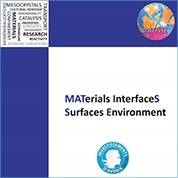INTERFACES, TRANSPORT, REACTIVITY IN NATURAL MEDIA
Diffusion and reactivity at surfaces from molecular to geological scale
Objectives
Molecular scale reactions at solid‐solution interface associated to transport and diffusion processes in porous media strongly affect the behaviour of a large range of materials and finds numerous environmental and technological applications in geology, biochemistry, electrochemistry, catalysis, conservation, etc. The theme 3 aims to answer current challenges in these fields, dealing notably with:
- Understanding of transport properties of charged or neutral species within porous matrices,
- Modelling of mechanical and chemical behaviours at interfaces, for instance the redox chemistry of solid‐solution interfaces
- Assessment of fluid/rock geological records and determination of mass/fluid transfers,
- Long‐term evolution of toxic compounds in natural systems
- Preservation of cultural heritage materials that are prone to mechanical damage because of oxidation and hydration phenomena.
Partner Teams
ISTEP, IMPMC, LCMCP, LRS, LISE, PHENIX, LG-PASTEUR, IFP‐EN, CRC, C2RMF, LRMH.
Funded projects
- 2012- Carbon recycling in subduction zones : a naturalist approach – Alberto Vitale Brovarone Post-doc / IMPMC (O. Beyssac); ENS geology (C. Chopin)
- 2012- Development of surfactant based biocide coatings for the preservation of architectural heritage – Claire Valotteau PhD / LCMCP (N. Baccile); LRS (V. Humblot), LRMH (F. Bousta)
- 2014- Impact of swelling clays physico-mechanical properties on architectural stones PhD, Mathilde Thiennot / LRMH (A. Bourges, J.D. Mertz); ENS-geology (J. Fortin, Y. Guéguen)
- 2014- NMR (MRI) study of the impregnation of aluminium oxide carriers by aqueous solutions of metallic salts Post Doc, Agnieszka Nowacka / LCMCP (F. Genneau, A. Gédéon); IFP-EN (A. Quoineaud)
- 2014- Development of a new generation of electrodes for direct electronic transfer of bio-batteries PhD, Achraf Blout / LRS (C. Jolivalt); LISE (A. Pailleret, H. Perrot)
Highlights
Five projects were accepted for funding. Among these, three projects just started. The two others are either fully completed (Post doc of A. Vitale Brovarone) or in the final year (PhD of C. Valotteau).
As the theme 3 is intrinsically interdisciplinary, the selected projects cover a wide range of fields mostly related to geochemistry, electrochemistry, and catalysis. Many of the projects have applied objectives, such as catalysis application with the impregnation of alumina supports with aqueous solutions of metal salts (Cu, Co ...) in order to improve the performance of heterogeneous catalysts used in refining, or electrochemistry with the development of a new generation of electrodes for biofuel cells.
Some projects are specifically dedicated to cultural heritage applications while developing fundamental research aspects. One of them is focused on the development of antifouling layers for materials of historical interest (limestone rock, concrete), based on natural glycolipid biomolecules. Fundamental adsorption studies on gold surfaces were performed. They demonstrated the possibility to immobilize sophorolipids on different surfaces keeping their antimicrobial properties (Figure 4). It suggests that the observed biocidal activity results from the interaction of the disaccharide with the bacterial walls, which had never been reported in the literature.
Another one aims to study swelling properties of clay minerals and their impact on monumental stone alteration. The main concern corresponds to peeling phenomena observed on architectural heritage buildings (Figure 5). The nature and the distribution of clay particles in the porous network are key factors to understand the hydro-mechanical behavior of these stones and their degradation. The project combines micro-scale characterization of stones with non-destructive acoustic measurements and fracture mechanic tests in order to propose a model for stone weathering.
Figure 4: Sophorolipids grafted on Au surface exhibt biocid properties against on Gram+ bacteria, Listeria ivanovii. PhD work of C. Valotteau.
Figure 5: Peeling process on molasses from Villarlod - Fribourg City Hall © LRMH. PhD work of M. Tiennot.
Among projects dealing with Earth science, one post-doctoral project has been completed. It concerned carbon recycling in subduction zones. This research aimed to study the behaviour of volatile substance in the subduction zone, especially those involving water and carbon, by combining naturalistic approach and advanced mineralogy and geochemistry techniques. A new mechanism of water transfer to the deep earth was discovered and it was shown that the carbon is not as stable as expected in this subduction zone [see 5, 6, 7]. Since october 2014, Dr Vitale Brovarone, is appointed permanent researcher at CNRS (section 18).
Benefits of MATISSE
An obvious added value in this research field has been to establish bridges between teams with very different cultures. As demonstrated above, this research theme is intrinsically interdisciplinary and selected projects cover a wide range of fields mostly related to geochemistry, electrochemistry, and catalysis. The most important aspect is the diversity of scales addressed in the projects, almost from the nanoscale to planetary processes. MATISSE just makes the bridge, which is true and effective.
Also in the section
Key figures
MATISSE :
4 disciplines
- Chemistry
- Physics
- Earth Science
- Cultural heritage
18 partners
400 researchers
Contact
Direction :
Florence Babonneau
Administration :
Laurence Bonnet-Lericque
Communication :
Tél. (33) 1 44 27 62 36




